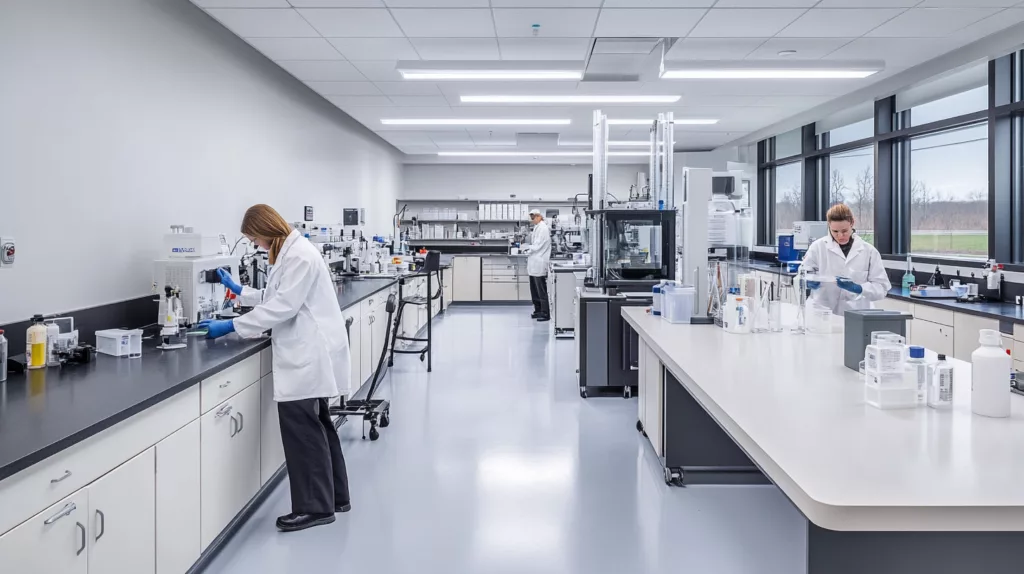Introduction
When it comes to crafting, repairs, or general DIY tasks, choosing the right adhesive is crucial for ensuring durability and success. Among the most commonly used bonding agents are superglue and acrylics—two versatile adhesives that serve different purposes and have distinct characteristics. While both are known for their strong adhesive properties, their composition, application, and uses vary widely. Understanding the difference between superglue and acrylics can make a world of difference in your projects, whether you’re gluing materials together, painting, or working on intricate designs.
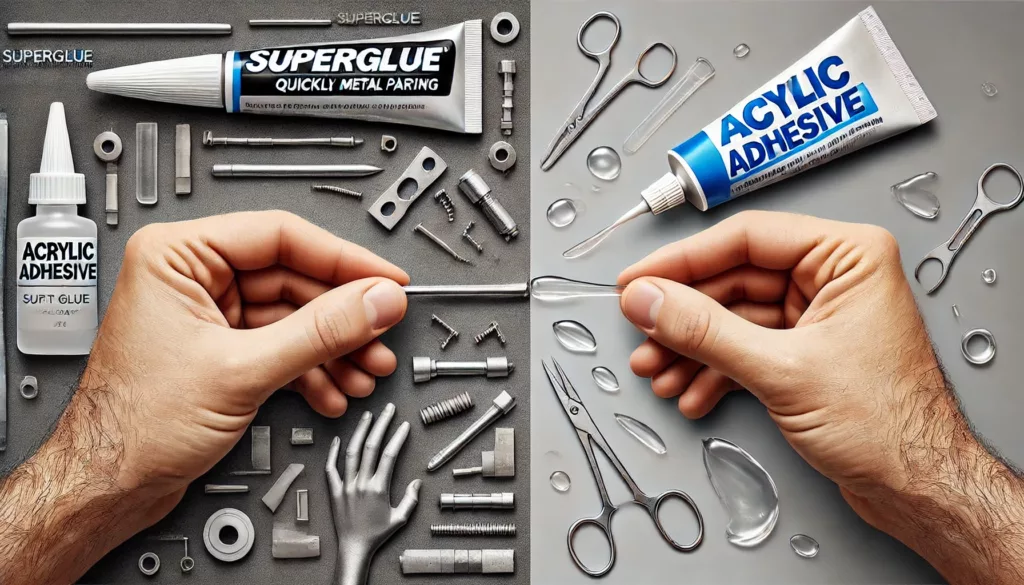
In this article, we’ll explore how superglue and acrylics differ in their chemical properties, applications, and effectiveness. By the end of this guide, you will have a clear understanding of which adhesive best suits your needs.
What is Superglue?
Superglue, chemically known as cyanoacrylate, is a fast-drying adhesive that bonds surfaces together through a process called polymerization. It forms a strong bond almost instantly, making it a popular choice for quick fixes and delicate repairs.

Superglue’s primary strength lies in its ability to adhere to almost any surface, from metal and plastic to ceramics and wood. However, superglue works best on non-porous materials and typically creates a rigid bond. The glue sets in a matter of seconds but requires a few minutes to fully cure, depending on the materials being joined.
Pros of Superglue
- Quick drying: Bonds within seconds.
- Strong bond: Holds tight even under pressure.
- Versatile: Works on a wide range of materials.
- Minimal mess: Small droplets make it easy to apply precisely.
Cons of Superglue
- Brittle: Tends to break under heavy stress or impact.
- Not ideal for porous materials: Does not bond well with fabric, foam, or other porous substances.
- Limited shelf life: Once opened, the bottle may dry out quickly.
What Are Acrylics?
Acrylics, on the other hand, refer to a group of adhesives or paints made from acrylic resins. While superglue is a single type of adhesive, acrylics come in various forms, including liquid adhesives and solid resin sheets. Acrylic Structural Adhesive are known for their clarity, flexibility, and versatility, making them suitable for both bonding and artistic projects.

Acrylic Adhesive is typically used for bonding glass, metal, and plastic. Unlike superglue, acrylic adhesives tend to be more flexible and allow for some movement after application, making them suitable for joints that may experience shifts or expansion. Acrylics are also more resistant to weathering and UV rays, making them ideal for outdoor applications.
Pros of Acrylic Adhesives
- Flexible bond: Works well for joints that might expand or contract.
- Resistant to UV and weathering: Ideal for outdoor and high-moisture environments.
- Clear finish: Produces a transparent, smooth finish perfect for decorative items.
- Long-lasting: Stays effective for long periods without degrading.
Cons of Acrylic Adhesives
- Longer drying time: Acrylic adhesives take longer to cure than superglue.
- Requires precision: The application can be tricky without the right tools or experience.
- Not as strong for heavy-duty bonding: While strong, it is not always as instant or robust as superglue.
Key Differences Between Superglue and Acrylics
Understanding the difference between superglue and acrylics is essential for choosing the right adhesive for your specific needs. Below are the most notable distinctions between the two:
| Characteristic | Superglue | Acrylics |
|---|---|---|
| Composition | Cyanoacrylate polymer | Acrylic resin (varies with type) |
| Bonding Speed | Extremely fast, bonds within seconds | Slower curing time, typically takes several minutes to hours |
| Bond Strength | Very strong on non-porous surfaces | Generally strong, but may not bond as quickly |
| Flexibility | Rigid bond, can break under stress | Flexible bond, allows for slight movement |
| Resistance | Can become brittle over time and under pressure | Resistant to UV, weather, and temperature changes |
| Ideal Surface | Best for small, non-porous materials (metal, plastic) | Best for glass, ceramics, and plastics |
| Application Method | Simple, direct application | May require mixing or specific tools for precision |
| Durability | Shorter lifespan, especially once exposed to air | Long-lasting, suitable for outdoor use |
When to Use Superglue?
Superglue’s quick-setting and strong adhesive properties make it perfect for applications that require fast results. Here are some scenarios where superglue is the ideal choice:
- Quick Repairs: Whether it’s a broken ceramic vase, cracked phone screen, or loose button on your shirt, superglue is the best solution for fast, temporary fixes.
- Non-porous Surfaces: If you’re working with smooth materials like metal, plastic, or glass, superglue bonds well and provides a strong, durable connection.
- Small Projects: For tiny components or delicate work, like jewelry making or assembling small plastic models, superglue offers precision and ease.
However, be mindful of its brittleness under strain. Superglue is not suitable for heavy-duty applications or projects that involve stress or weight-bearing.
When to Use Acrylics?
Acrylic adhesives are more suitable for applications that need flexibility, long-lasting bonds, and resistance to environmental elements. Here are some cases where acrylics should be your go-to adhesive:
- Outdoor Projects: Acrylic adhesives excel in harsh weather conditions. They resist UV rays and moisture, making them perfect for garden decorations, outdoor signage, or automotive repairs.
- Glass and Transparent Projects: If you’re working with glass, clear acrylic adhesives provide a strong bond while maintaining transparency and smoothness.
- Flexible Joints: For materials that may expand or contract, such as plastics or metals that experience temperature shifts, acrylic adhesives offer a more forgiving bond that will not crack or break.
If you need an adhesive for a longer-lasting and versatile bond, particularly in projects exposed to the elements, acrylics will outshine superglue.
What Materials Should You Avoid Using Superglue and Acrylics On?

Though both superglue and acrylics are versatile, there are certain materials that either adhesive is not suitable for:
- Superglue:
- Fabric: Superglue doesn’t bond well with porous materials like fabrics, and it can create stiff, uncomfortable patches.
- Foam: Superglue may cause foam to break down or become damaged.
- Paper: It can cause paper to wrinkle and may not form a secure bond.
- Acrylic Adhesives:
- Certain Plastics: Some plastics, particularly polyethylene or polypropylene, do not bond well with acrylic adhesives.
- Porous Materials: While acrylics can bond to many surfaces, it is not as effective on porous materials like wood or textiles.
FAQs About Superglue and Acrylics
What is the difference in drying times between superglue and acrylics?
Superglue dries almost instantly, forming a bond in just seconds. In contrast, acrylic adhesives take longer to cure, ranging from several minutes to hours, depending on the type and environmental conditions.
Can I use superglue on wood?
Yes, superglue can work on wood, especially if it’s smooth and non-porous. However, it may not be the best option for large surfaces or projects requiring flexibility.
Are acrylic adhesives waterproof?
Yes, most acrylic adhesives are waterproof, making them suitable for outdoor and underwater applications, unlike superglue, which may degrade under prolonged exposure to water.
Which adhesive is better for DIY projects?
For small, quick fixes, superglue is an excellent choice due to its fast drying time. However, if you’re working with larger or more complex projects that require flexibility and long-lasting bonds, acrylic adhesives are often the better option.
Can acrylic adhesives be used for glass?
Yes, acrylic adhesives are ideal for glass bonding, providing a clear, strong bond that can withstand the test of time.
Is superglue safe for skin?
While superglue bonds quickly to skin, it is generally safe in small amounts. However, it’s best to handle it with care and avoid prolonged exposure.
Conclusion
In summary, the difference between superglue and acrylics comes down to their properties, applications, and how they handle various materials. Superglue is best for quick, small-scale repairs on non-porous surfaces, while acrylic adhesives offer more flexibility, UV resistance, and are ideal for outdoor or larger projects. By understanding these differences, you can ensure that you choose the right adhesive for your specific needs, achieving the best results in your crafting, repairs, or DIY endeavors.




